Triassic Thermal Pulse of TARIM Mantle Plume: Evidence from Geochronology, Geochemistry, and Nd Isotopes of the Mafic Dikes from the Halaqi Area, Xinjiang, China
Abstract
:1. Introduction
2. Regional Geological Background
3. Petrography
4. Sampling and Analytical Methods
4.1. Whole-Rock Major and Trace Element Analyses
4.2. Sr and Nd Isotopic Ratio Measurements
4.3. Zircon U–Pb Dating
5. Results
5.1. Zircon U–Pb Geochronology
5.2. Major Element Compositions
5.3. Trace Elements
5.4. Sr–Nd Isotopic Compositions
6. Discussion
6.1. Petrogenic Age
6.2. Petrogenesis
6.3. Source Characteristics
6.4. Tectonic Significance
7. Conclusions
- (1)
- The Halaqi mafic dikes belong to the high-K calc-alkaline rock series and are characterized by an enrichment in LILEs (e.g., Sr, Th, and U) and HFSEs (e.g., Zr and Hf) and a depletion in HFSEs (e.g., Nb, Ta, and P), showing metasomatized lithospheric mantle signatures of the asthenospheric mantle in magma sources. They experienced little fractional crystallization with negligible crustal contamination. Zircon U–Pb dating suggests that the Halaqi mafic dikes were emplaced during the middle-to-late Triassic (247–201 Ma).
- (2)
- The Triassic mafic magmatism in northwest Tarim could be the product of the continuous thermal pulse of the Tarim mantle plume and be a part of the Tarim LIP. It has a source and a tectonic setting similar to those of the Tarim LIP, and both are products of the interaction between asthenospheric and lithospheric mantles in an intraplate environment.
Author Contributions
Funding
Data Availability Statement
Acknowledgments
Conflicts of Interest
References
- Wei, X.; Xu, Y.G.; Luo, Z.Y.; Zhao, J.X.; Feng, Y.X. Composition of the Tarim mantle plume: Constraints from clinopyroxene antecrysts in the early Permian Xiaohaizi dykes, NW China. Lithos 2015, 230, 69–81. [Google Scholar] [CrossRef]
- Xu, Y.G.; Wei, X.; Luo, Z.Y.; Liu, H.Q.; Jun, C. The Early Permian Tarim Large Igneous Province: Main characteristics and a plume incubation model. Lithos 2014, 204, 20–35. [Google Scholar] [CrossRef]
- Luo, J.H.; Che, Z.C.; Zhou, X.Y.; Li, Y.; Li, J.L.; Zhang, J.Y. Diabase evidence for the early Mesozoic extension in the western Tarim basin, NW China. Geol. China 2006, 33, 566–571. (In Chinese) [Google Scholar]
- Hu, C.B.; Li, P.Q.; Gu, P.Y.; Chen, R.M.; Zha, X.F.; Zhuang, Y.J. Geochronoogical and geochemical study of the late triassic layered mafic-ultramfic intrusions in Beishan area of Wushi county, southwest Tianshan. J. Geomech. 2016, 22, 1015–1033. [Google Scholar]
- Zheng, F.; Li, X.Y.; Shang, M.L.; Feng, C.W. Xinjiang Keping Kazima Early Triassic fold mafic complex geochemical characteristics and tectonic significance of rock mass. Xinjiang Geol. 2016, 34, 84–92. (In Chinese) [Google Scholar]
- Yan, K.; Sun, J.G.; Dai, Y.X.; Ma, W. Triassic stretching in the Northwest Tarim Basin: Evidence from geochemical characteristics and zircon U-Pb chronology of diabase in the Keping area, Xinjiang, China. Chin. J. Geol. 2021, 56, 237–252. (In Chinese) [Google Scholar]
- Zhu, Z.X.; Dong, L.H.; Wang, K.Z.; Zhao, T.Y.; Xu, S.Q.; Chen, B.X.; Li, P.; Jin, L.Y. Tectonic division and regional tectonic evolution of West Tianshan organic belt. Geol. Bull. China 2013, 32, 297–306. (In Chinese) [Google Scholar]
- Zou, Y.R.; Ta, J.G.L.; Xing, Z.Y.; Xu, Z.L.; Tang, T.T.; Hao, Y.W. Evolution of Sedimentary Basins in Tarim during Neoproterozoic-Paleozoic. Earth Sci. J. China Univ. Geosci. 2014, 8, 1200–1216. (In Chinese) [Google Scholar]
- Gao, X.F.; Lin, X.; Xu, Y.D.; Yue, M.L. Evolution of Sedimentary Basins in South Tianshan during Paleozoic-Mesozoic. Earth Sci. J. China Univ. Geosci. 2014, 8, 1119–1128. (In Chinese) [Google Scholar]
- Bryan, S.E.; Ernst, R.E. Revised definition of Large Igneous Provinces (LIPs). Earth Sci. Rev. 2008, 86, 175–202. [Google Scholar] [CrossRef]
- Lu, L.; Zhang, Y.T.; Li, Z.F.; Zhang, K.J. Petrogenesis of the alkali basalt and trachy-andesite suite in the northern Tarim Basin, NW China: Implications for crust-mantle interactions controlled by the Permian mantle plume. Gondwana Res. 2023, 119, 86–103. [Google Scholar] [CrossRef]
- Jiang, C.Y.; Zhang, P.B.; Lu, D.R.; Bai, K.Y. Petrogenesis and magma source of the ultramafic rocks at Wajilitag region, Western Tarim Plate in Xinjiang. Acta Petrol. Sin. 2004, 20, 132–143. (In Chinese) [Google Scholar]
- Yang, S.F.; Li, Z.L.; Chen, H.L.; Xiao, W.J.; Yu, X.; Lin, X.B.; Shi, X.G. Discovery of a Permian quartz syenitic porphyritic dyke from the Tarim basin and its tectonic implications. Acta Petrol. Sin. 2006, 22, 1405–1412. (In Chinese) [Google Scholar]
- Borisenko, A.S.; Sotnikov, V.I.; Izokh, A.E.; Polyakov, G.V.; Obolensky, A.A. Permo-Triassic mineralization in Asia and its relation to plume magmatism. Russian Geol. Geophys. 2006, 47, 166–182. [Google Scholar]
- Pirajno, F.; Ernst, R.E.; Borisenko, A.S.; Fedoseev, G.; Naumov, E.A. Intraplate magmatism in Central Asia and China and associated metallogeny. Ore Geol. Rev. 2009, 35, 114–136. [Google Scholar] [CrossRef]
- Tian, W.; Campbell, I.H.; Allen, C.M.; Guan, P.; Pan, W.; Chen, M.; Yu, H.; Zhu, W. The Tarim picrite–basalt–rhyolite suite–a Permian flood basalt from northwest China with contrasting rhyolites produced by fractional crystallization and anatexis. Contrib. Mineral. Petrol. 2010, 160, 407–425. [Google Scholar] [CrossRef]
- Zhu, G.Y.; Zhang, K.J. Did the eruption of the Tarim LIP control the formation of Paleozoic hydrocarbon reservoirs in the Tarim basin, China? Gondwana Res. 2022, 101, 224–232. [Google Scholar] [CrossRef]
- Dai, Y.X.; Zhang, X.Y.; Yan, K.; Li, L.L.; Yang, B.Z.; Zhao, Z.G.; Zhou, Q.; Sun, Z.J.; Wang, B.; Gao, H. Zircon U–Pb Chronology, Geochemical Characteristics of the Early Permian Basalt in the Keping Area, Xinjiang and Their Geological Significance. Geol. Sci. Technol. Inf. 2017, 36, 1–13. (In Chinese) [Google Scholar]
- Chen, H.L.; Yang, S.F.; Dong, C.W.; Zhen, G.Q.; Jia, C.Z.; Wei, G.Q.; Wang, Z.G. Geological Hot Event of the Tarim Basin. Chin. Sci. Bull. 1997, 42, 1096–1099. (In Chinese) [Google Scholar]
- Chen, H.L.; Yang, S.F.; Dong, C.W. Confirmation of Permian basite zone in Tarimbasin and its Tectonic Significance. Geochimica 1997, 26, 77–87. (In Chinese) [Google Scholar]
- Yang, S.F.; Chen, H.L.; Dong, C.W. The Discovery of Permian Syenite inside Tarimbasin and its Geodynamic Significance. Geochimica 1996, 25, 121–128. (In Chinese) [Google Scholar]
- Yang, S.F.; Li, Z.L.; Chen, H.L. Permian bimodal dyke of Tarim Basin, NW China: Geochemical characteristics and tectonic implications. Gondwana Res. 2007, 12, 113–120. [Google Scholar] [CrossRef]
- Yang, S.F.; Chen, H.L.; Li, Z.L. Early Permian Tarim Large Igneous Province in northwest China. Sci. China Earth Sci. 2014, 56, 2015–2026. (In Chinese) [Google Scholar] [CrossRef]
- Yang, Y.H.; Wu, F.Y.; Liu, Z.C.; Chu, Z.Y.; Xie, L.W.; Yang, J.H. Evaluation of Sr chemical purification technique for natural geological samples using common cation-exchange and Sr-specific extraction chromatographic resin prior to MC–ICP–MS or TIMS measurement. J. Anal. At. Spectrom. 2012, 27, 516–522. [Google Scholar] [CrossRef]
- Balcaen, L.; De Schrijver, I.; Moens, L.; Vanhaecke, F. Determination of the 87Sr/86Sr isotope ratio in USGS silicate reference materials by multi-collector ICP-mass spectrometry. Int. J. Mass Spectrom. 2005, 242, 251–255. [Google Scholar] [CrossRef]
- Jweda, J.; Bolge, L.; Class, C.; Goldstein, S.L. High precision Sr-Nd-Hf-Pb isotopic compositions of USGS reference material BCR-2. Geostand. Geoanal. Res. 2016, 40, 101–115. [Google Scholar] [CrossRef]
- Liu, Y.S.; Hu, Z.C.; Gao, S. In Situ Analysis of Major and Trace Elements of Anhydrous Minerals by LA–ICP–MS without applying an internal standard. Chem. Geol. 2008, 257, 34–43. [Google Scholar] [CrossRef]
- Ludwing, K.R. User’s Manual for Isoplot 3.00: A Geochronological Toolkit for Microsoft Excel; Special Publication; Berkeley Geochronology Center: Berkeley, CA, USA, 2003; pp. 1–74. [Google Scholar]
- Hou, K.J.; Li, Y.H.; Tian, Y.R. In situ U–Pb zircon dating using laser ablation–multion counting ICP–MS. Miner. Depos. 2009, 28, 481–492. (In Chinese) [Google Scholar]
- Hoskin, P.W.O.; Black, L.P. Metamorphic zircon formation by Solid–state recrystallization of protolith igneous zircon. J. Metamorph. Geol. 2000, 18, 423–439. [Google Scholar] [CrossRef]
- Le Maitre, R.W.; Streckeisen, A.; Zanettin, B.; Le Bas, M.J.; Bonin, B.; Bateman, P. Igneous rocks: A classification and glossary of terms. Min. Eng. 2002, 8, 26–5187. [Google Scholar]
- Zhang, X.Y.; Yan, K.; Li, L.L.; Yin, Y.H.; Han, X.M.; Zhao, P.F. The Report on Regional Geological and Mineral Investigation of Keping, Xinjiang; The 7th Gold Department of People’s Armed Police: Yantai, China, 2018; pp. 118–121. (In Chinese) [Google Scholar]
- Sun, L.H.; Wang, Y.J.; Fan, W.M.; Peng, T.P. Petrogenesis and tectonic significances of the diabase dikes in the Bachu Area, Xinjiang. Acta Petrol. Sin. 2007, 23, 1369–1380. (In Chinese) [Google Scholar]
- Sun, S.S.; McDonough, W.F. Chemical and isotopic systematics and oceanic basalts: Implication for mantle composition and processes. Magmatism in the Ocean Basins. Geol. Soc. Spec. Publ. 1989, 42, 313–345. [Google Scholar] [CrossRef]
- Andreeva, O.A.; Dubinina, E.; Andreeva, I.A.; Yarmolyuk, V.V.; Bychkov, A.; Borisova, A.; Ji, J.; Zhou, X.; Kovalchuk, E.V.; Borisovsky, S.Y.; et al. Mechanism of carbonate assimilation by intraplate basaltic magma and liquid immiscibility: Example of Wangtian’s volcano (Changbaishan volcanic area, NE China). Front. Earth Sci. 2023, 11, 1306460. [Google Scholar] [CrossRef]
- Borisova, A.Y.; Bohrson, W.A. How is carbonate crust digested by magma? Front. Earth Sci. 2023, 11, 1186207. [Google Scholar] [CrossRef]
- Li, Y.; Su, W.; Kong, P.; Qian, Y.X.; Zhang, M.L.; Chen, Y.; Cai, X.Y.; You, D.H. Zircon U–Pb ages of the Early Permian magmatic rocks in the Tazhong–Bachu region, Tarim basin by LA–ICP–MS. Acta Petrol. Sin. 2007, 23, 1097–1107. (In Chinese) [Google Scholar]
- Yu, X.; Yang, S.F.; Chen, H.L.; Chen, Z.Q.; Li, Z.L.; Batt, G.E.; Li, Y.Q. Permian flood basalts from the Tarim Basin, Northwest China: SHRIMP zircon U–Pb dating and geochemical characteristics. Gondwana Res. 2011, 20, 485–497. [Google Scholar] [CrossRef]
- Wu, H.X.; Huang, W.K.; Li, Y.Q.; Lin, X.B.; Chen, H.L.; Chen, X.G.; Zhang, F.Q. Discovery of Permian mafic sills intrusion event in the Sinian system, Northwest Tarim block. Acta Geol. Sin. 2020, 94, 1869–1882. (In Chinese) [Google Scholar]
- Zhang, H.A.; Li, Y.J.; Wu, G.Y.; Su, W.; Qian, Y.X.; Meng, Q.L.; Cai, X.Y.; Han, L.J.; Zhao, Y.; Liu, Y.L. Isotopic geochronology of Permian igneous rocks in the Tarim Basin. Chin. J. Geol. 2009, 44, 137–158. (In Chinese) [Google Scholar]
- Taylor, S.R.; Mclennan, S.M. The geochemical evolution of the continental crust. Rev. Geophys. 1995, 33, 241–265. [Google Scholar] [CrossRef]
- Xia, L.Q.; Xia, Z.C.; Xu, X.Y.; Li, X.M.; Ma, Z.P. The discrimination between continental basalt and island arc basalt based on geochemical method. Acta Petrol. Mineral. 2007, 26, 77–89. (In Chinese) [Google Scholar]
- Sun, J.; Liang, T.; Li, H.; Yan, K.; Chao, Y.; Wang, Z. Implications for Metallogenesis and Tectonic Evolution of Ore-Hosting Granodiorite Porphyry in the Tongkuangyu Cu Deposit, North China Craton: Evidence from Geochemistry, Zircon U-Pb Chronology, and Hf Isotopes. Minerals 2022, 12, 273. [Google Scholar] [CrossRef]
- Woodhead, J.D.; McCulloch, M.T. Ancient seafloor signals in Pitcairn Island lavas and evidence for large amplitude, small length-scale mantle heterogeneities. Earth Planet. Sci. Lett. 1989, 94, 257–273. [Google Scholar] [CrossRef]
- Hofmann, A.W.; Jochum, K.P.; Seufert, M.; White, W.M. Nb and Pb in oceanic basalts: New constraints on mantle evolution. Earth Planet. Sci. Lett. 1986, 79, 33–45. [Google Scholar] [CrossRef]
- Jochum, K.; McDonough, W.; Palme, H.B.; Spettel, B. Compositional constraints on the continental lithospheric mantle from trace elements in spinel peridotite xenoliths. Nature 1989, 340, 548–550. [Google Scholar] [CrossRef]
- Li, X.H.; Chen, Z.G.; Liu, D.Y.; Li, W.X. Jurassic gabbro–granite syenite suites from southern Jiangxi province, SE China: Age, origin, and tectonic significance. Int. Geol. Rev. 2003, 45, 898–921. [Google Scholar] [CrossRef]
- Pearce, J.A. Trace element characteristics of lavas from destructive plate boundaries. In Orogenic Andesites and Related; Thorpe, R.S., Ed.; John Wiley and Sons: Hoboken, NJ, USA, 1982; pp. 525–548. [Google Scholar]
- Zhang, Y.T.; Liu, J.Q.; Guo, Z.F. Permian basaltic rocks in the Tarim basin, NW China: Implications for plume–lithosphere interaction. Gondwana Res. 2010, 18, 596–610. [Google Scholar] [CrossRef]
- Li, Z.L.; Chen, H.L.; Song, B. Temporal evolution of the Permian large igneous province in Tarim Basin in northwestern China. J. Asian Earth Scis. 2011, 42, 917–927. [Google Scholar] [CrossRef]
- Sun, J.G.; Li, H.Y.; Liu, X.H.; Xie, K.Q.; Li, B.L.; Yin, D.W. Alteration and mineralization characteristics of Tongkuangyu copper deposit in Zhongtiao Mountain, Shanxi Province. Miner. Depos. 2014, 33, 1306–1324. (In Chinese) [Google Scholar]
- Li, Y.Q.; Li, Z.L.; Sun, Y.L.; Santosh, M.; Langmuir, C.H.; Chen, H.L.; Yang, S.F.; Chen, Z.X.; Yu, X. Platinum-group elements and geochemical characteristics of the Permian continental flood basalts in the Tarim Basin, northwest China: Implications for the evolution of the Tarim Large Igneous Province. Chem. Geol. 2012, 328, 278–289. [Google Scholar] [CrossRef]
- Zhang, C.L.; Li, Z.X.; Li, X.H. A Permian large igneous province in Tarim and Central Asian orogenic belt, NW China: Results of a ca.275 Ma mantle plume? Soc. Am. Bull. 2010, 122, 2020–2040. [Google Scholar] [CrossRef]
- Zhou, M.F.; Zhao, J.H.; Jiang, C.Y.; Gao, J.F.; Wang, W.; Yang, S.H. OIB-like, heterogeneous mantle sources of Permian basaltic magmatism in the western Tarim Basin, NW China: Implications for a possible Permian large igneous province. Lithos 2009, 113, 583–594. [Google Scholar] [CrossRef]
- Jiang, C.Y.; Zhang, P.B.; Lu, D.R.; Bai, K.Y.; Wang, Y.P.; Tang, S.H.; Wang, J.H.; Yang, C. Petrology, Geochemistry and Petrogenesis of the Kalpin Basalts and Their Nd, Sr and Pb Isotopic Compositions. Geol. Rev. 2004, 50, 492–500. (In Chinese) [Google Scholar]
- Deniel, C. Geochemical and isotopic (Sr–Nd–Pb) evidence for plume–lithosphere interactions in the genesis of Grand Comore magmas (Indian Ocean). Chem. Geol. 1988, 144, 281–303. [Google Scholar] [CrossRef]
- Ernst, R.E.; Buchan, K.L.; Campbell, I.H. Frontiers in large igneous province research. Lithos 2005, 79, 271–297. [Google Scholar] [CrossRef]
- Li, J.Y.; Wang, K.Z.; Li, Y.P.; Sun, G.H.; Chu, C.H.; Li, L.Q.; Zhu, Z.X. Geomorphological features, crustal composition and geological evolution of the Tianshan Mountains. Geol. Bull. China 2006, 25, 895–909. (In Chinese) [Google Scholar]
- Xu, X.Y.; Li, R.S.; Chen, J.L.; Ma, Z.P.; Li, Z.P.; Wang, H.L.; Bai, J.K.; Tang, Z. New constrains on the Paleozoic tectonic evolution of the northern Xinjiang area. Acta Petrol. Sin. 2014, 30, 1521–1534. (In Chinese) [Google Scholar]
- Parsons, T. The Basin and Range province. In Continental Rifts: Evolution, Structure, Tectonics; Olsen, K.H., Ed.; Elsevier: Amsterdam, The Netherlands, 1995; pp. 277–316. [Google Scholar]
- Li, Q.H.; Zhang, K.J.; Yan, L.L.; Jin, X. Contrasting latest Permian intracontinental gabbro and Late Triassic arc gabbro–diorite in the Gangdese constrain the subduction initiation of the Neo-Tethys. Int. Geol. Rev. 2020, 63, 2356–2375. [Google Scholar] [CrossRef]
- Pearce, J.A.; Norry, M.J. Petrogenetic implications of Ti, Zr, Y and Nb Variations in volcanic rocks. Contrib. Mineral. Petrol. 1979, 69, 33–47. [Google Scholar]
- Sun, J.G.; Li, H.Y.; Liu, X.H.; Xie, K.Q.; Chen, W.; Xue, S.S.; Sun, X.L. Characteristics of Chlorite from the Tongkuangyu Copper Deposit in Shanxi Province and Their Geological Implications. Bull. Mineral. Petrol. Geochem. 2015, 34, 1142–1154. (In Chinese) [Google Scholar]
- Gao, J.; Qian, Q.; Long, L.L.; Zhang, X.; Li, J.L.; Su, W. Accretionary orogenic process of western Tianshan, China. Geol. Bull. China 2009, 28, 1804–1816. (In Chinese) [Google Scholar]


 —measuring point.
—measuring point.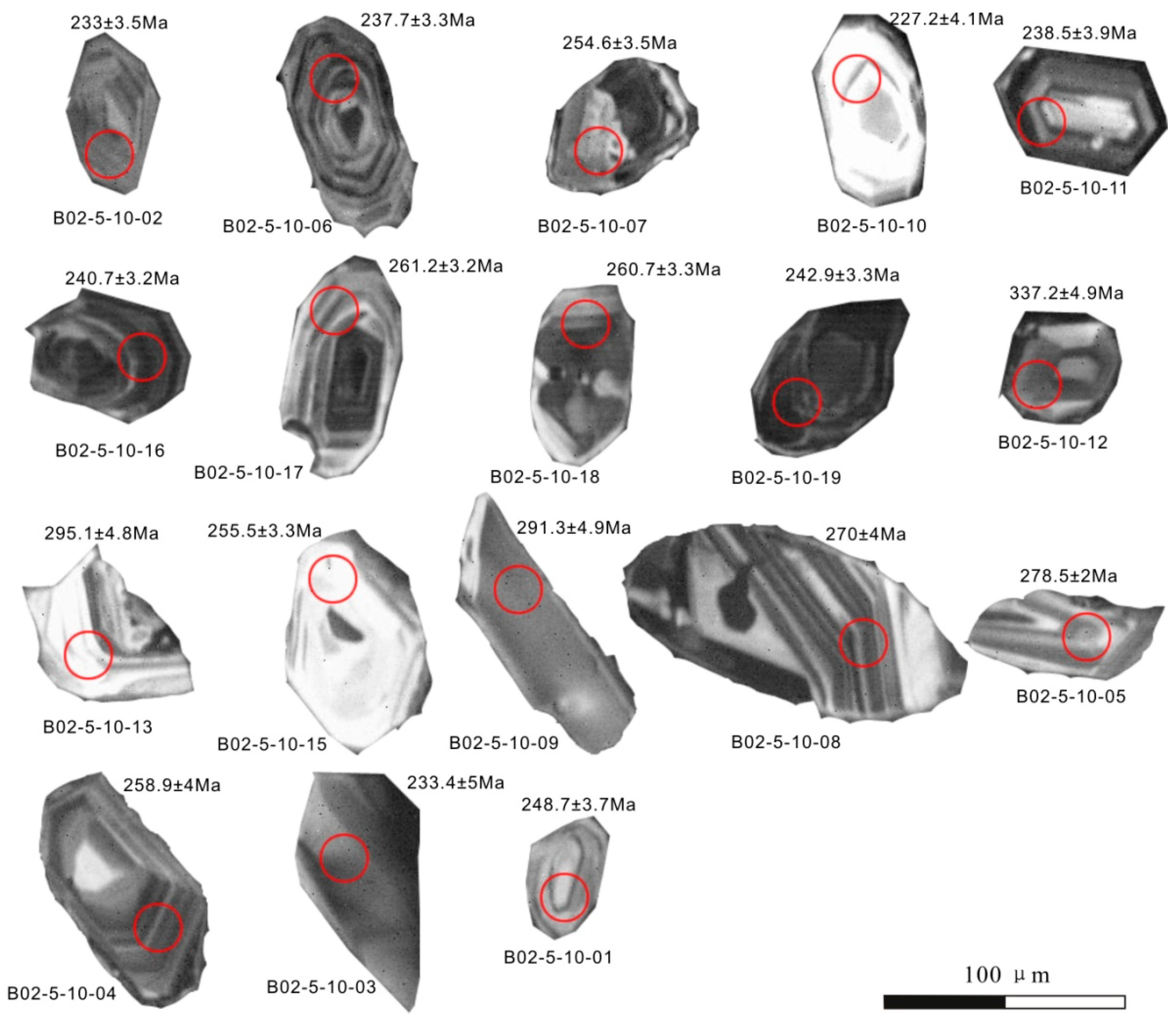


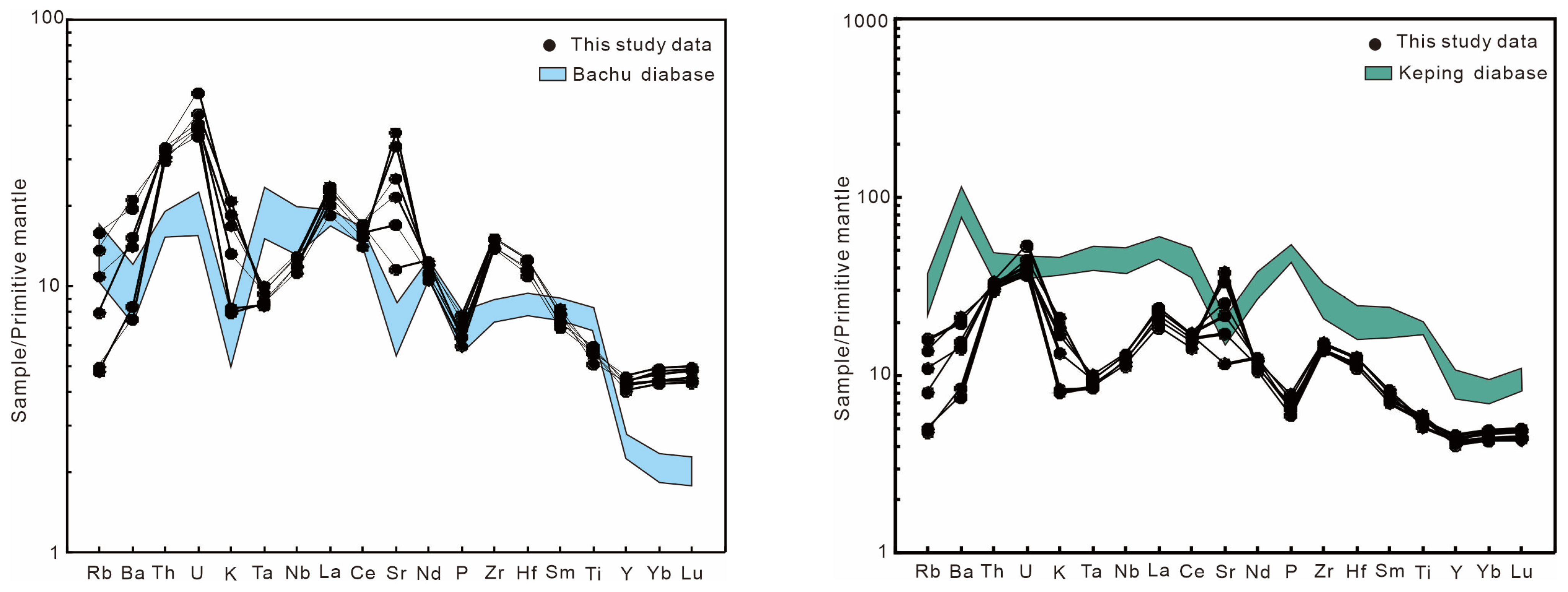
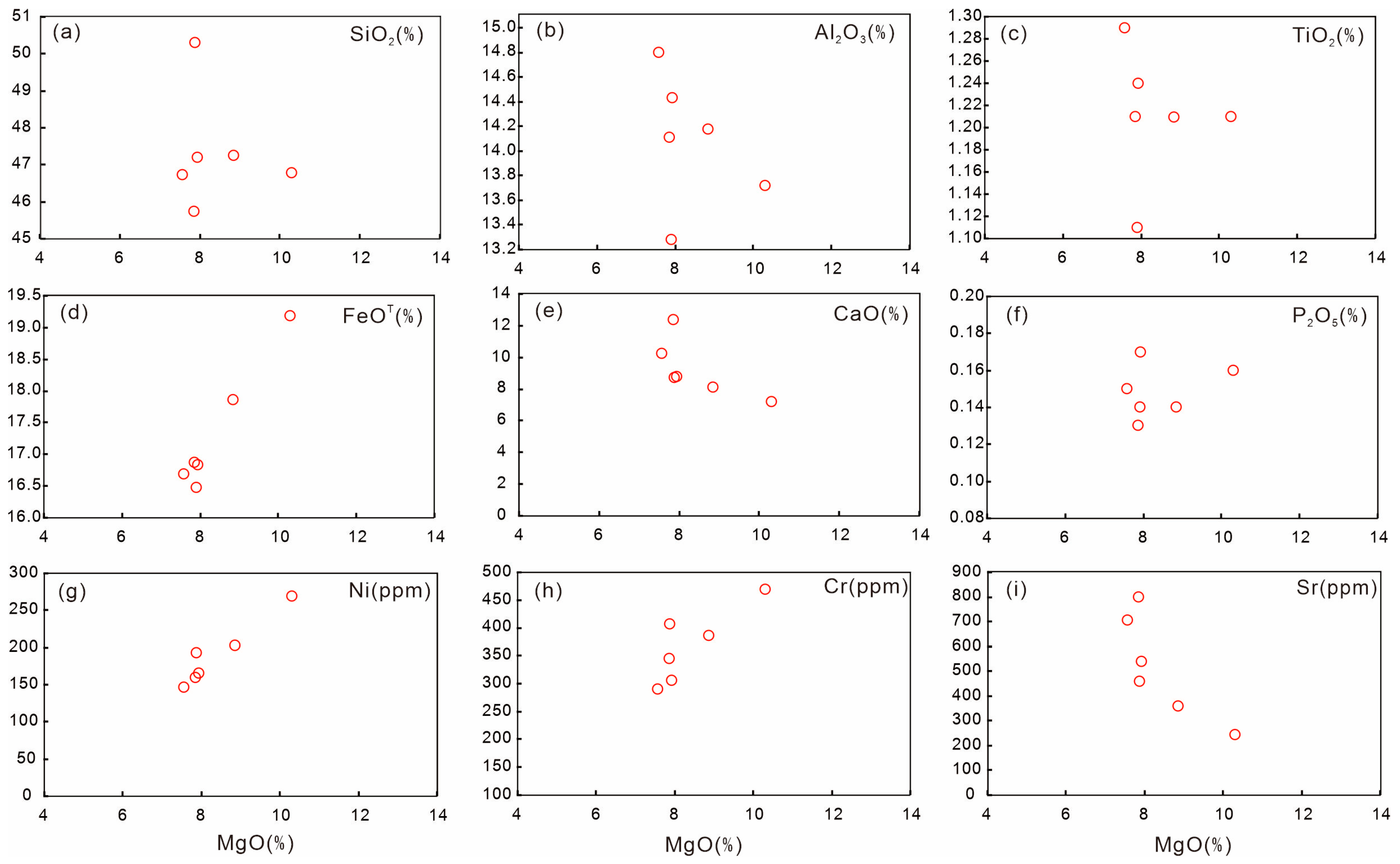
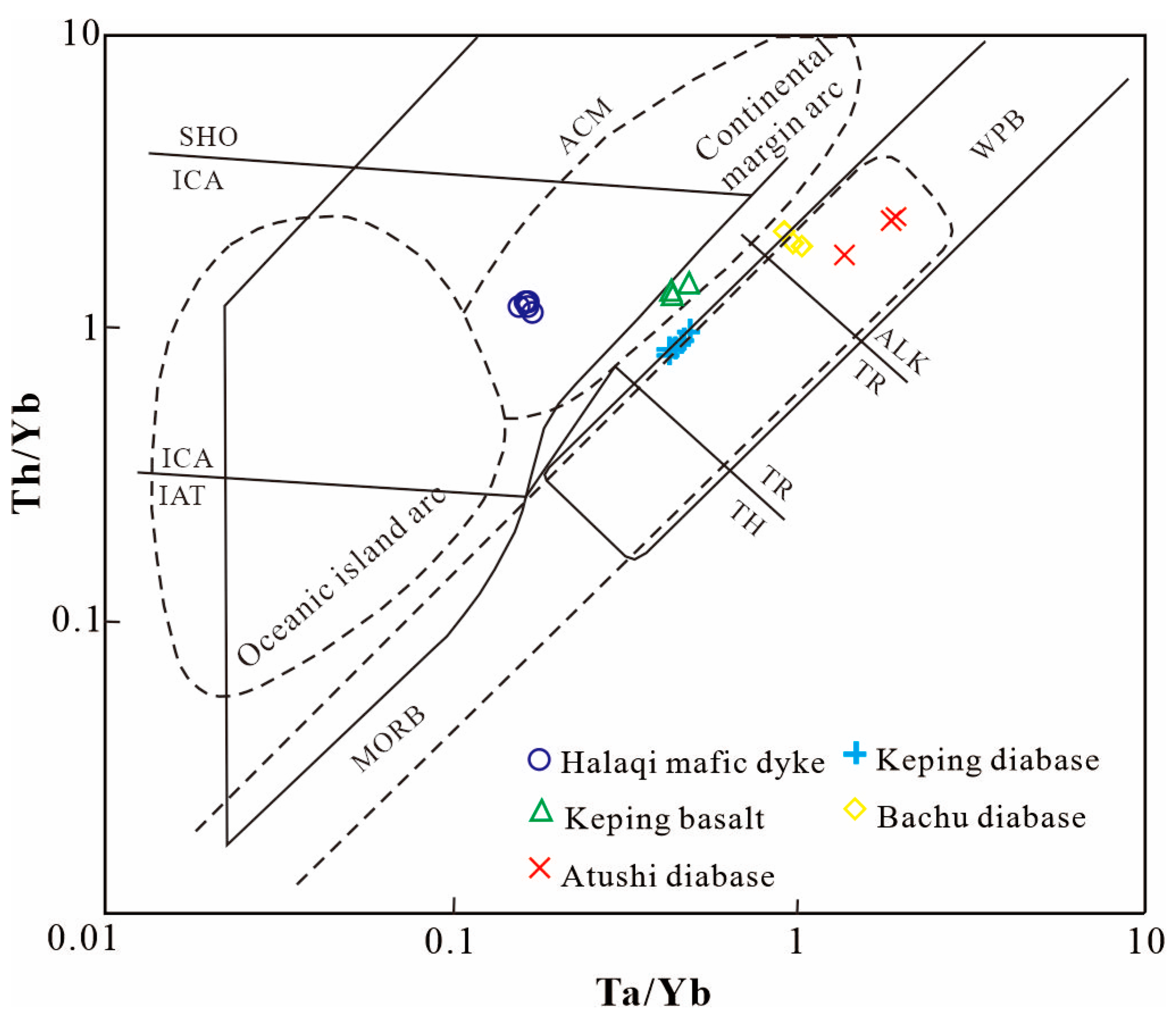
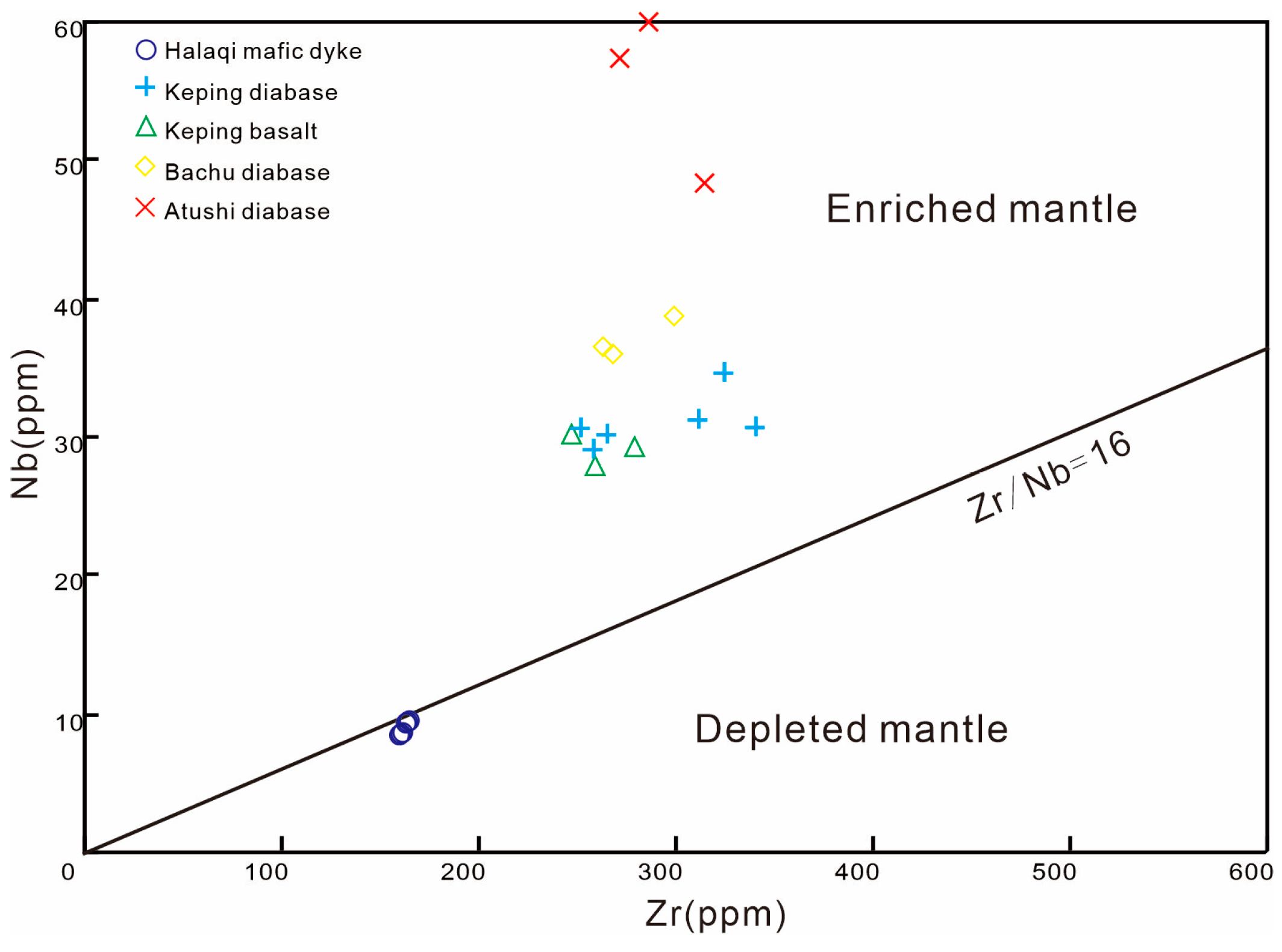


| Measuring Points | Th | U | Th/U | Isotopic Ratios | Isotopic Ages (Ma) | ||||||||||
|---|---|---|---|---|---|---|---|---|---|---|---|---|---|---|---|
| (ppm) | 207Pb/206Pb | 207Pb/235U | 206Pb/238U | 207Pb/206Pb | 207Pb/235U | 206Pb/238U | |||||||||
| Ratio | 1σ | Ratio | 1σ | Ratio | 1σ | Age | 1σ | Age | 1σ | Age | 1σ | ||||
| B02-5-10-02 | 199 | 451 | 0.44 | 0.056 | 0.0026 | 0.2821 | 0.012 | 0.0368 | 0.0006 | 454 | 104 | 252 | 10 | 233 | 3 |
| B02-5-10-06 | 301 | 395 | 0.76 | 0.0542 | 0.0023 | 0.284 | 0.012 | 0.0376 | 0.0005 | 389 | 94 | 254 | 9 | 238 | 3 |
| B02-5-10-07 | 143 | 393 | 0.36 | 0.0498 | 0.002 | 0.2803 | 0.0115 | 0.0403 | 0.0006 | 183 | 93 | 251 | 9 | 255 | 4 |
| B02-5-10-10 | 83.5 | 248 | 0.34 | 0.0506 | 0.0032 | 0.2512 | 0.0153 | 0.0359 | 0.0007 | 233 | 144 | 228 | 12 | 227 | 4 |
| B02-5-10-11 | 165 | 395 | 0.42 | 0.0511 | 0.0026 | 0.2671 | 0.0138 | 0.0377 | 0.0006 | 256 | 120 | 240 | 11 | 238 | 4 |
| B02-5-10-16 | 790 | 734 | 1.08 | 0.0513 | 0.0019 | 0.2711 | 0.0104 | 0.0381 | 0.0005 | 254 | 87 | 244 | 8 | 241 | 3 |
| B02-5-10-17 | 478 | 1080 | 0.44 | 0.0495 | 0.0015 | 0.2859 | 0.009 | 0.0414 | 0.0005 | 172 | 69 | 255 | 7 | 261 | 3 |
| B02-5-10-18 | 497 | 497 | 1 | 0.0528 | 0.002 | 0.3031 | 0.0121 | 0.0413 | 0.0005 | 320 | 87 | 269 | 9 | 261 | 3 |
| B02-5-10-19 | 318 | 952 | 0.33 | 0.0493 | 0.0014 | 0.2628 | 0.0077 | 0.0384 | 0.0005 | 161 | 69 | 237 | 6 | 243 | 3 |
| B02-5-10-12 | 268 | 387 | 0.69 | 0.0502 | 0.0019 | 0.3761 | 0.0149 | 0.0537 | 0.0008 | 206 | 89 | 324 | 11 | 337 | 5 |
| B02-5-10-13 | 269 | 355 | 0.76 | 0.0476 | 0.0022 | 0.3111 | 0.0151 | 0.0468 | 0.0008 | 79.7 | 107.4 | 275 | 12 | 295 | 5 |
| B02-5-10-15 | 157 | 575 | 0.27 | 0.0495 | 0.002 | 0.2787 | 0.0112 | 0.0404 | 0.0005 | 169 | 93 | 250 | 9 | 256 | 3 |
| B02-5-10-09 | 430 | 262 | 1.64 | 0.0524 | 0.0028 | 0.3343 | 0.0178 | 0.0462 | 0.0008 | 302 | 122 | 293 | 14 | 291 | 5 |
| B02-5-10-08 | 150 | 554 | 0.27 | 0.0568 | 0.0024 | 0.3345 | 0.0143 | 0.0428 | 0.0006 | 483 | 94 | 293 | 11 | 270 | 4 |
| B02-5-10-05 | 203 | 256 | 0.79 | 0.055 | 0.0141 | 0.3108 | 0.1788 | 0.0441 | 0.0035 | 413 | 488.8 | 275 | 14 | 279 | 2 |
| B02-5-10-04 | 285 | 573 | 0.5 | 0.0529 | 0.0021 | 0.3001 | 0.0119 | 0.041 | 0.0006 | 324 | 93 | 267 | 9 | 259 | 4 |
| B02-5-10-03 | 71.6 | 148 | 0.48 | 0.0499 | 0.0049 | 0.2471 | 0.0219 | 0.0369 | 0.0008 | 191 | 215 | 224 | 18 | 233 | 5 |
| B02-5-10-01 | 149 | 441 | 0.34 | 0.0511 | 0.0023 | 0.2766 | 0.0121 | 0.0393 | 0.0006 | 243 | 73 | 248 | 10 | 249 | 4 |
| Sample Number | P56-19-1 | P56-19-2 | P56-19-3 | P56-19-4 | P56-19-5 | P56-19-6 |
|---|---|---|---|---|---|---|
| SiO2 (%) | 45.74 | 47.26 | 47.19 | 46.73 | 46.77 | 50.31 |
| TiO2 | 1.21 | 1.21 | 1.24 | 1.29 | 1.21 | 1.11 |
| Al2O3 | 14.11 | 14.18 | 14.43 | 14.8 | 13.72 | 13.28 |
| Fe2O3 | 12.3 | 12.34 | 12.07 | 12.16 | 13.1 | 11.05 |
| FeO | 5.8 | 6.75 | 5.98 | 5.75 | 7.4 | 6.53 |
| MnO | 0.15 | 0.15 | 0.15 | 0.15 | 0.16 | 0.14 |
| MgO | 7.86 | 8.86 | 7.94 | 7.58 | 10.32 | 7.9 |
| CaO | 12.39 | 8.12 | 8.77 | 10.26 | 7.19 | 8.71 |
| Na2O | 2.97 | 3.91 | 4.5 | 3.65 | 3.85 | 3.58 |
| K2O | 0.24 | 0.63 | 0.4 | 0.25 | 0.51 | 0.56 |
| P2O5 | 0.13 | 0.14 | 0.17 | 0.15 | 0.16 | 0.14 |
| Loss on ignition | 2.72 | 3.06 | 2.94 | 2.84 | 2.88 | 3.10 |
| Total amount | 99.82 | 99.86 | 99.8 | 99.86 | 99.87 | 99.88 |
| Na2O + K2O | 3.21 | 4.54 | 4.90 | 3.90 | 4.36 | 4.14 |
| K2O/Na2O | 0.08 | 0.16 | 0.09 | 0.07 | 0.13 | 0.16 |
| CaO/Al2O3 | 0.88 | 0.57 | 0.61 | 0.69 | 0.52 | 0.66 |
| Mg# | 0.71 | 0.70 | 0.70 | 0.70 | 0.71 | 0.68 |
| FeOT | 16.87 | 17.86 | 16.84 | 16.69 | 19.19 | 16.48 |
| La (ppm) | 12.7 | 14.9 | 15.8 | 13.9 | 15.7 | 16.3 |
| Ce | 25.1 | 28.3 | 30.1 | 27.1 | 30 | 30.5 |
| Pr | 3.31 | 3.6 | 3.88 | 3.43 | 3.88 | 3.9 |
| Nd | 14.3 | 15.2 | 16.3 | 15 | 16.9 | 16.5 |
| Sm | 3.1 | 3.29 | 3.49 | 3.23 | 3.67 | 3.53 |
| Eu | 1.18 | 1.2 | 1.22 | 1.26 | 1.29 | 1.28 |
| Gd | 3.12 | 3.34 | 3.58 | 3.31 | 3.75 | 3.66 |
| Tb | 0.706 | 0.745 | 0.79 | 0.749 | 0.84 | 0.817 |
| Dy | 3.73 | 3.85 | 4.07 | 3.88 | 4.26 | 4.15 |
| Ho | 0.722 | 0.741 | 0.788 | 0.749 | 0.816 | 0.794 |
| Er | 2.07 | 2.11 | 2.27 | 2.16 | 2.41 | 2.32 |
| Tm | 0.324 | 0.333 | 0.362 | 0.341 | 0.372 | 0.367 |
| Yb | 2.12 | 2.17 | 2.32 | 2.19 | 2.42 | 2.37 |
| Lu | 0.321 | 0.328 | 0.355 | 0.335 | 0.369 | 0.362 |
| Y | 18.4 | 19.2 | 20.2 | 19.5 | 20.9 | 19.9 |
| Sc | 28.4 | 32.6 | 29.6 | 30 | 28.4 | 31.8 |
| V | 242 | 244 | 235 | 247 | 215 | 219 |
| Co | 47.7 | 59.5 | 54.9 | 49.1 | 63.2 | 54.5 |
| Ni | 160 | 202 | 166 | 146 | 269 | 194 |
| Cu | 48.5 | 53.7 | 124 | 164 | 58.7 | 41.7 |
| Zn | 56.7 | 81.5 | 65.1 | 61.9 | 98.7 | 67.8 |
| Ga | 20 | 19.8 | 20.3 | 20.6 | 19.1 | 19.6 |
| Rb | 3.17 | 8.7 | 5.07 | 3.04 | 10.1 | 6.93 |
| Sr | 800 | 360 | 536 | 707 | 245 | 458 |
| Zr | 155 | 156 | 170 | 157 | 168 | 170 |
| Nb | 8.01 | 8.44 | 9.09 | 8.48 | 9.27 | 9.2 |
| Cs | 0.087 | 0.068 | 0.054 | 0.049 | 0.085 | 0.063 |
| Ba | 52.6 | 148 | 107 | 58.8 | 137 | 98.7 |
| Hf | 3.39 | 3.55 | 3.88 | 3.59 | 3.86 | 3.9 |
| Ta | 0.355 | 0.358 | 0.387 | 0.347 | 0.411 | 0.387 |
| Pb | 2.33 | 2.03 | 1.59 | 2.05 | 1.88 | 1.92 |
| Th | 2.51 | 2.6 | 2.8 | 2.61 | 2.74 | 2.84 |
| U | 0.823 | 0.932 | 0.855 | 0.769 | 0.817 | 1.12 |
| ΣREE | 72.80 | 80.11 | 85.33 | 77.64 | 86.68 | 86.85 |
| LREE | 59.69 | 66.49 | 70.79 | 63.92 | 71.44 | 72.01 |
| HREE | 13.11 | 13.62 | 14.54 | 13.72 | 15.24 | 14.84 |
| LREE/HREE | 4.55 | 4.88 | 4.87 | 4.66 | 4.69 | 4.85 |
| LaN/YbN | 4.30 | 4.93 | 4.89 | 4.55 | 4.65 | 4.93 |
| δEu | 1.15 | 1.10 | 1.05 | 1.17 | 1.05 | 1.08 |
| δCe | 0.93 | 0.92 | 0.91 | 0.93 | 0.92 | 0.91 |
| Sample Number | P56-19-1 | P56-19-2 | P56-19-3 | P56-19-5 | P56-19-6 |
|---|---|---|---|---|---|
| Rb (ppm) | 24.6 | 1.84 | 1.16 | 5.85 | 1.43 |
| Sr (ppm) | 96.4 | 147 | 86.4 | 328 | 136 |
| 87Rb/86Sr | 0.7402 | 0.0362 | 0.0389 | 0.0516 | 0.0303 |
| 87Sr/86Sr | 0.707702 | 0.70738 | 0.707628 | 0.706511 | 0.706884 |
| (87Sr/86Sr)i | 0.70491 | 0.70724 | 0.70748 | 0.70632 | 0.70677 |
| εSr(t) | 10.3 | 43.4 | 46.8 | 30.2 | 33.8 |
| Sm (ppm) | 3.25 | 2.73 | 3.04 | 4.03 | 3.25 |
| Nd (ppm) | 14.2 | 12.1 | 14.7 | 17.6 | 14.5 |
| 147Sm/144Nd | 0.138 | 0.1361 | 0.1251 | 0.1383 | 0.1352 |
| 143Nd/144Nd | 0.512478 | 0.512522 | 0.512432 | 0.512475 | 0.512481 |
| (143Nd/144Nd)i | 0.512239 | 0.512286 | 0.512215 | 0.512235 | 0.512246 |
| εNd(t) | −1.1 | −0.2 | −1.6 | −1.2 | −1.0 |
| fSm/Nd | −0.30 | −0.31 | −0.36 | −0.30 | −0.31 |
| TDM (Ma) | 1355 | 1236 | 1237 | 1367 | 1301 |
| T2DM (Ma) | 1128 | 1053 | 1165 | 1133 | 1115 |
Disclaimer/Publisher’s Note: The statements, opinions and data contained in all publications are solely those of the individual author(s) and contributor(s) and not of MDPI and/or the editor(s). MDPI and/or the editor(s) disclaim responsibility for any injury to people or property resulting from any ideas, methods, instructions or products referred to in the content. |
© 2024 by the authors. Licensee MDPI, Basel, Switzerland. This article is an open access article distributed under the terms and conditions of the Creative Commons Attribution (CC BY) license (https://creativecommons.org/licenses/by/4.0/).
Share and Cite
Sun, J.; Liang, T.; Liu, X.; Zhang, X.; Liu, B.; Quan, G. Triassic Thermal Pulse of TARIM Mantle Plume: Evidence from Geochronology, Geochemistry, and Nd Isotopes of the Mafic Dikes from the Halaqi Area, Xinjiang, China. Minerals 2024, 14, 283. https://doi.org/10.3390/min14030283
Sun J, Liang T, Liu X, Zhang X, Liu B, Quan G. Triassic Thermal Pulse of TARIM Mantle Plume: Evidence from Geochronology, Geochemistry, and Nd Isotopes of the Mafic Dikes from the Halaqi Area, Xinjiang, China. Minerals. 2024; 14(3):283. https://doi.org/10.3390/min14030283
Chicago/Turabian StyleSun, Jungang, Ting Liang, Xiaohuang Liu, Xiong Zhang, Bei Liu, and Guorong Quan. 2024. "Triassic Thermal Pulse of TARIM Mantle Plume: Evidence from Geochronology, Geochemistry, and Nd Isotopes of the Mafic Dikes from the Halaqi Area, Xinjiang, China" Minerals 14, no. 3: 283. https://doi.org/10.3390/min14030283





